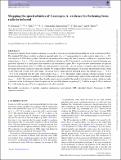Files in this item
Mapping the spectral index of Cassiopeia A : evidence for flattening from radio to infrared
Item metadata
| dc.contributor.author | Domček, V | |
| dc.contributor.author | Vink, J | |
| dc.contributor.author | Hernández Santisteban, J V | |
| dc.contributor.author | DeLaney, T | |
| dc.contributor.author | Zhou, P | |
| dc.date.accessioned | 2021-02-26T12:30:09Z | |
| dc.date.available | 2021-02-26T12:30:09Z | |
| dc.date.issued | 2021-03 | |
| dc.identifier | 272951551 | |
| dc.identifier | 979e4035-33ec-4d05-87fa-153be509d761 | |
| dc.identifier | 000649423200068 | |
| dc.identifier | 85117310429 | |
| dc.identifier.citation | Domček , V , Vink , J , Hernández Santisteban , J V , DeLaney , T & Zhou , P 2021 , ' Mapping the spectral index of Cassiopeia A : evidence for flattening from radio to infrared ' , Monthly Notices of the Royal Astronomical Society , vol. 502 , no. 1 , pp. 1026-1040 . https://doi.org/10.1093/mnras/staa3896 | en |
| dc.identifier.issn | 0035-8711 | |
| dc.identifier.other | Jisc: 15cb28cc6260415087d6650a15629b12 | |
| dc.identifier.other | ORCID: /0000-0002-6733-5556/work/89178816 | |
| dc.identifier.uri | https://hdl.handle.net/10023/21514 | |
| dc.description | Funding: The work of VD is supported by a grant from the NWO graduate programme/GRAPPA-PhD programme. JVHS acknowledges support from the STFC grant ST/R000824/1. | en |
| dc.description.abstract | Synchrotron radiation from supernova remnants is caused by electrons accelerated through diffusive shock acceleration (DSA). The standard DSA theory predicts an electron spectral index of p = 2, corresponding to a radio spectral index of α = −0.5. An extension of DSA theory predicts that the accelerated particles change the shock structure, resulting in a spectrum that is steeper than p > 2 (α < −0.5) at low energies and flattens with energy. For Cassiopeia A, a synchrotron spectral flattening was previously reported for a small part of the remnant in the mid-infrared regime. Here, we present new measurements for spectral flattening using archival radio (4.72 GHz) and mid-infrared (3.6 μm) data, and we produce a complete spectral index map to investigate the spatial variations within the remnant. We compare this to measurements of the radio spectral index from L-band (1.285 GHz) and C-band (4.64 GHz) maps. Our result shows overall spectral flattening across the remnant (αR-IR ∼ −0.5 to −0.7), to be compared with the radio spectral index of αR = −0.77. The flattest values coincide with the locations of most recent particle acceleration. In addition to overall flattening, we detect a relatively steeper region in the south-east of the remnant (αR-IR ∼ −0.67). We explore whether these locally steeper spectra could be the result of synchrotron cooling, which provides constraints on the local magnetic field strengths and the age of the plasma, suggesting B ≲ 2 mG for an age of 100 yr, and even B ≲ 1 mG using the age of Cas A, in agreement with other estimates. | |
| dc.format.extent | 15 | |
| dc.format.extent | 11976336 | |
| dc.language.iso | eng | |
| dc.relation.ispartof | Monthly Notices of the Royal Astronomical Society | en |
| dc.subject | Acceleration of particles | en |
| dc.subject | Radiation mechanisms: non-thermal | en |
| dc.subject | ISM: individual objects: Cassiopeia A | en |
| dc.subject | ISM: supernova remnants | en |
| dc.subject | QB Astronomy | en |
| dc.subject | QC Physics | en |
| dc.subject | DAS | en |
| dc.subject.lcc | QB | en |
| dc.subject.lcc | QC | en |
| dc.title | Mapping the spectral index of Cassiopeia A : evidence for flattening from radio to infrared | en |
| dc.type | Journal article | en |
| dc.contributor.institution | University of St Andrews. School of Physics and Astronomy | en |
| dc.identifier.doi | https://doi.org/10.1093/mnras/staa3896 | |
| dc.description.status | Peer reviewed | en |
This item appears in the following Collection(s)
Items in the St Andrews Research Repository are protected by copyright, with all rights reserved, unless otherwise indicated.

